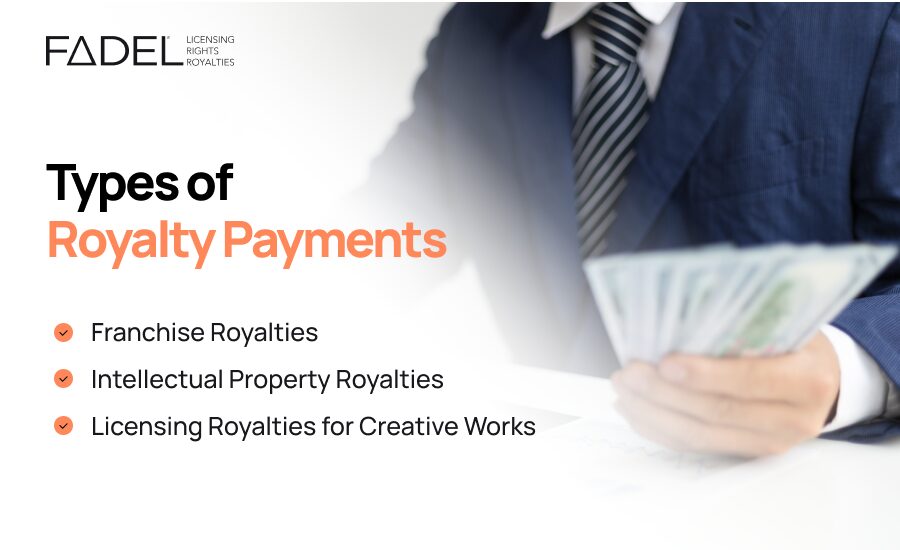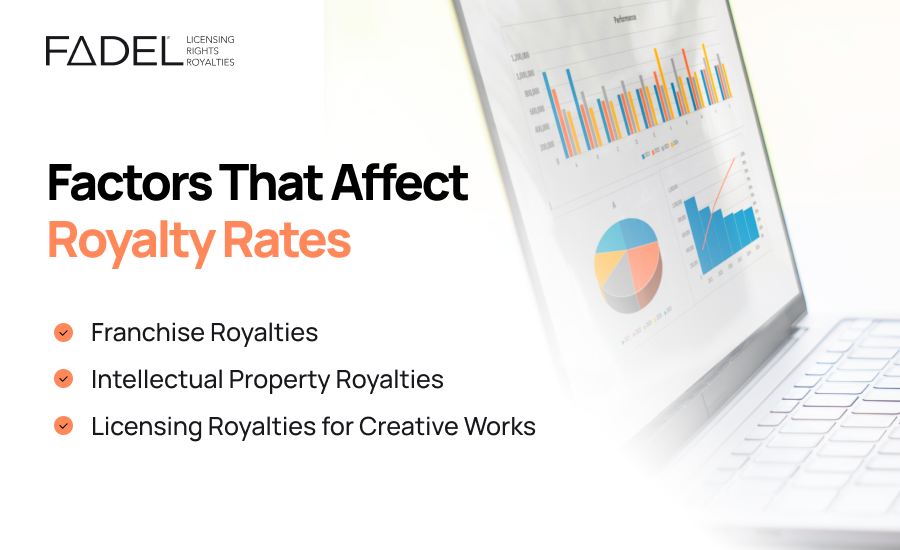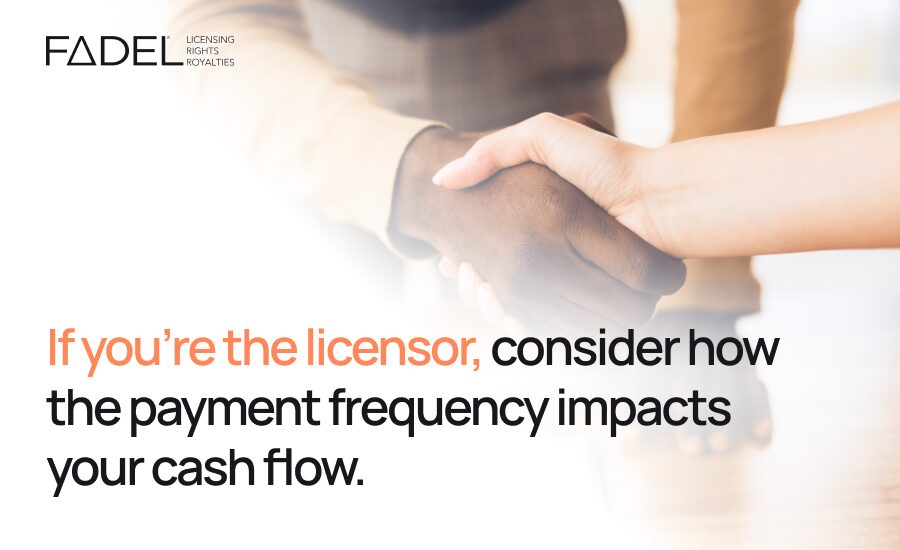What Is Royalty in Business? Key Takeaways
- A royalty is a recurring payment made to an IP owner by a third party for the right to use that property
- Payment terms are defined in a licensing agreement between the intellectual property owner and the user
- Royalty amounts are typically a percentage of revenue, influenced by factors like exclusivity and proprietary technology
Royalty payments turn ideas into income, allowing creators to profit from their intellectual property or enabling businesses to tap into popular brands to boost sales.
But what exactly is royalty in business, and why should you care?
In this guide, we will:
- Break down how royalty payments work in real-world scenarios
- Explore the key factors that influence royalty rates and deal terms
- Understand the steps of applying a royalty payment cycle, from agreement to payout
- Highlight how FADEL solutions streamline royalty management
Royalty in Business Explained
Royalties are recurring payments made for the use of intellectual property (IP), such as copyrights, patents, trademarks, or other protected rights.
Individuals or companies can license IP like logos, trademarks, or patented technologies, granting others permission to use it under defined terms.
Royalties are often calculated as a percentage of revenue but can also be based on units sold, net profits, or fixed fees.
Payment terms, including duration and frequency, are tailored to the agreement between the licensor and licensee.
3 Types of Royalty Payments
Royalty payments aren’t one-size-fits-all, as they depend on the type of asset and how the deal is structured.
Let’s break down three of the most common types you’ll come across:
1. Franchise Royalties
Franchise royalties are paid by franchisees to franchisors in exchange for the right to operate under an established brand.
These payments grant access to the franchisor’s business model, including branding, intellectual property, and operational systems.
This model is especially common in the fast-food industry; about 93% of McDonald’s restaurants, for example, are independently franchised.
Royalty fees are usually based on a percentage of gross or net sales, although some agreements use a flat-rate structure instead.
2. Intellectual Property Royalties
Intellectual property (IP) royalties are paid by licensees who wish to use or commercialize protected assets, such as patents, trademarks, and copyrighted content.
These royalties are common in industries like technology, pharmaceuticals, and manufacturing.
They also play a critical role in the consumer goods sector, particularly in licensing brands, characters, or artwork for use in toys, video games, apparel, merchandise, and collectibles.
For example, entertainment giants like Disney and Marvel license their characters to toy companies, which pay royalties in return for the right to produce branded products.
Similarly, Apple pays patent royalties to companies like Qualcomm for the modems used in its iPhones.
3. Licensing Royalties for Creative Works
These royalties apply to the use of creative content, such as music, literature, film, or visual art, outside of its original context.
Rather than selling the work outright, creators or rights holders license its use, often for purposes like advertising, entertainment, merchandise, and publishing.
In the publishing world, for example, licensing may involve paying royalties for the right to reuse:
- Written works by authors
- Illustrations
- Instructional videos
- Quizzes
- Other educational materials for inclusion in textbooks or digital platforms
While educational publishing is a structured and collaborative environment for content licensing, the entertainment industry also sees high-stakes royalty negotiations driven by the reuse of creative work.
A high-profile case illustrating this type of royalty involved pop artist Olivia Rodrigo, who reportedly paid over $1 million in royalties to Taylor Swift and others for the interpolation of musical elements in her debut album SOUR.
This payout stemmed from licensing agreements required when incorporating recognizable parts of another artist’s work, reinforcing the importance and financial impact of copyright and licensing in the music industry.

How Do Royalties Work?
Royalties are governed by licensing agreements, where intellectual property (IP) holders grant usage rights to others in exchange for payment.
These payments might be structured as flat fees, percentage-based royalties, or hybrid models depending on the asset type and deal terms.
Each agreement should clearly define:
- The specific assets being licensed
- How royalty payments will be calculated
- The structure and frequency of those payments
But in practice, royalty agreements can be very complex. Terms can involve:
- Fixed or variable royalty rates
- Minimum guarantees and upfront advances
- Territory-specific pricing structures
- Bundled product configurations
- Milestone-based payment schedules
- Tiered rates and commission-based payouts
This level of complexity makes royalty management challenging and error-prone, especially as businesses scale across partners, regions, and platforms.
That’s where FADEL’s royalty management software becomes essential.
It automates calculations, tracks usage rights, enforces contract terms, and streamlines reporting.
More importantly, it provides full visibility into deal structures, financial obligations, and performance benchmarks, making it easier to stay compliant and minimize revenue leakage.
Even with the right tools, it’s still important to consult a licensing attorney when drafting or negotiating complex royalty agreements to ensure legal and financial risks are properly managed.
Factors That Influence Royalty Rates
A variety of commercial, contractual, and market-driven factors determine how much licensors can charge for the use of their assets.
Key considerations include:
- Asset value: The value of intellectual property, whether based on reputation, uniqueness, or market potential, can significantly influence royalty rates. High-profile or innovative assets often command higher payments.
- Bargaining power: A well-known artist or brand can often negotiate more favorable terms. On the flip side, licensees with strong marketing capabilities and a proven track record may also be in a position to push for better deals.
- Exclusivity: Granting exclusive rights or including a non-compete clause in the agreement can raise the royalty rate, as the licensee pays a premium for market control.
- Market demand: Licensors typically command higher rates when there’s strong interest in or anticipation for their product. For instance, think of a highly awaited album, book, or patented innovation.

Understanding and Managing the Royalty Payment Cycle
Understanding how the royalty payment cycle works can help you confidently license intellectual property.
Here’s a step-by-step breakdown of what a typical royalty arrangement looks like:
1. Establish a Royalty-Bearing Agreement
Every royalty relationship starts with a licensing agreement.
The licensor and licensee negotiate and formalize a contract that outlines the asset being licensed, the terms of its use, and how payments will be structured.
Here are a few expert tips for negotiating stronger terms:
- Specify the scope of use: Clearly define where and how the asset can be used, whether that’s by country, region, or across online and offline channels.
- Clarify exclusivity: Exclusivity can be used as leverage to negotiate higher royalties or better terms.
- Set the duration: Decide how long the agreement will last. Longer contracts offer stability; shorter ones allow for quicker renegotiation as market conditions shift.
2. Define the Payment Terms
Outline exactly how royalties will be paid. Most payment structures fall into one of the following models:
- Percentage of revenue: For example, a fast-food franchisee might pay 5% of net sales to the franchisor or tiered rates based on volume sales
- Fixed fee per unit: A toy designer might earn $2 for every licensed action figure sold
- Usage-based: A musician could receive royalties each time a track is streamed

3. Track Usage or Sales
The licensee is responsible for tracking product sales and reporting those figures to the licensor.
This typically happens on a monthly or quarterly schedule outlined in the contract.
Accurate and consistent reporting builds transparency and trust, two requirements for a healthy, long-term licensing relationship.
4. Calculate Royalty Payments
Once the numbers are in, the licensee calculates what’s owed based on the agreed terms.
A few variables may impact the final amount:
- Minimum guarantees: A baseline payment the licensor receives regardless of asset performance
- Advances: Upfront payments deducted from future royalties
- Deductions: Adjustments for customer returns or refunds
- Escalators: Royalty rates increase when the licensee reaches certain sales milestones
- Milestone or scheduled payouts: Payments triggered by predefined events or timelines, for example, an initial payment upon marketing launch and a second payout after meeting sales targets or delivery milestones
5. Make the Payment
The licensee pays the licensor according to the agreed schedule. This process often involves preparing and sending a licensor-specific royalty statement.
For licensees managing multiple contracts and licensors, generating accurate, compliant royalty statements can be a major pain point.
Manual processes often lead to delays, reporting errors, or non-compliance, putting partnerships and revenue at risk.
FADEL’s LicenSee platform solves this challenge by enabling licensees to:
- Generate ready-to-submit royalty statements tailored to each licensor’s unique specifications
- Automate calculations across complex deal terms
- Maintain accurate records and reduce administrative overhead
6. Auditing and Compliance
Most licensing agreements allow the licensor to audit the licensee’s financial records periodically.
These licensing audits verify that royalty payments match reported usage, providing a safety net and reinforcing the integrity of the agreement.
However, for licensees, audits can be resource-intensive and disruptive. Preparing for an audit often requires:
- Gathering detailed sales data and royalty reports
- Reconciling payments against complex contract terms
- Responding to licensor inquiries with precise documentation
LicenSee reduces audit time and costs by:
- Automating royalty calculations: Ensuring accuracy and reducing manual errors
- Generating licensor-specific royalty statements: Streamlining the reporting process
- Providing real-time compliance checks: Identifying potential violations before they escalate
- Maintaining comprehensive audit trails: Facilitating quick and accurate responses to audit inquiries
Take the Complexity Out of Royalty Management With FADEL
Managing royalties and licensing shouldn’t hold you back.
With FADEL’s IPM Suite and LicenSee Royalty Management, you gain end-to-end visibility and control, whether you’re licensing your IP or managing payments as a licensee.
Automate royalty calculations, ensure contract compliance, track usage rights, and generate accurate, audit-ready reports.
These powerful solutions are designed for both licensors and licensees, helping strengthen partnerships while reducing risk and revenue leakage.
Our other services include:
- Brand Vision: A brand protection tool that ensures licensing compliance by providing end-to-end visibility into rights ownership, talent contracts, and usage permissions. It safeguards brand integrity while optimizing workflows for marketing and product development teams.
- PictureDesk: A centralized media asset management solution tailored for image licensing and rights enforcement. It oversees image usage across teams, maintaining consistency, compliance, and alignment with brand guidelines.
When rights and royalties management becomes complex and high-stakes, count on FADEL to streamline operations, ensure compliance, and unlock your full revenue potential.
